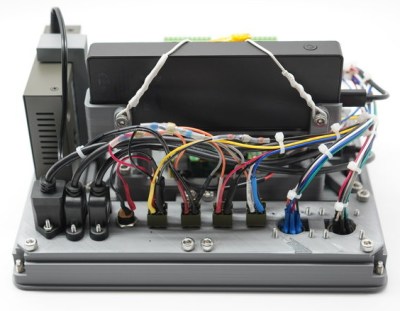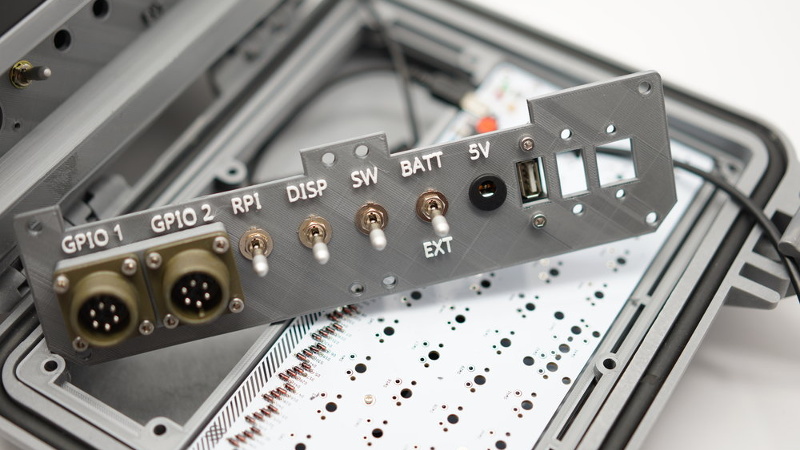If civilization goes sideways and you need to survive, what are the bare essentials that should go in your bunker? Food and fresh water, sure. Maybe something to barter with in case things go full on The Postman. That’s all sensible enough, but how’s that stuff going to help you get a LAN party going? If you’re anything like [Jay Doscher], you’ll make sure there’s a ruggedized Raspberry Pi system with a self-contained network with you when the bombs drop.
 Or at least, it certainly looks the part. He’s managed to design the entire project so it doesn’t require drilling holes through the Pelican case that serves as the enclosure, meaning it’s about as well sealed up as a piece of electronics can possibly be. The whole system could be fully submerged in water and come out bone dry on the inside, and with no internal moving parts, it should be largely immune to drops and shocks.
Or at least, it certainly looks the part. He’s managed to design the entire project so it doesn’t require drilling holes through the Pelican case that serves as the enclosure, meaning it’s about as well sealed up as a piece of electronics can possibly be. The whole system could be fully submerged in water and come out bone dry on the inside, and with no internal moving parts, it should be largely immune to drops and shocks.
But we imagine [Jay] won’t actually need to wait for nuclear winter before he gets some use out of this gorgeous mobile setup. With the Pi’s GPIO broken out to dual military-style panel mount connectors on the front, a real mechanical keyboard, and an integrated five port Ethernet switch, you won’t have any trouble getting legitimate work done with this machine; even if the closest you ever get to a post-apocalyptic hellscape is the garage with the heat off. We especially like the 3D printed front panel with integrated labels, which is a great tip that frankly we don’t see nearly enough of.
This is actually an evolved version of the Raspberry Pi Field Unit (RPFU) that [Jay] built back in 2015. He tells us that he wanted to update the design to demonstrate his personal growth as a hacker and maker over the last few years, and judging by the final product, we think it’s safe to say he’s on the right path.

















We already have this technology: the ZipLoc bag.
This is reminiscent of what we used to call “Red Seats” at EDS. Of course they were hardened against TEMPEST too.
” Maybe something to barter with in case things go full on The Postman. ”
Bottle-caps.
Also any article of clothing made with black leather especially if it has metal studs and large shoulder pads and lots and lots of belts and chains.
Plus V8 hop up parts,any kind of spiky metal you can attach to a vehicle and big mud tires you know for reasons.
Are we dure we want anything propriatery when the world ends? Oth it would be something fun tot do while we want fort extinction, tot reverse engineering the bootloader that is …
Are we sure we want something that is made with RoHS solder BGAs and flash chips with an average data retention time of about a decade?
Take a hundred of these, and half will be broken by the end of five years – especially if they actually have to tolerate less than NTP environments. For example, I’ve already had Arduinos conk out just form being out in the cold – but they mysteriously recover after a few days when you bring them back indoors….
For example, the LAN9512 controller on the RPi is only rated for 0 – 70 C operating range. If they’ve used regular unleaded tin, simply placing the device in cold storage for months (<13 C) can destroy it because it may develop tin rot.
So much for your apocalypse computer.
I found older stuff made with DIP and gull wing lead parts seem to be the most durable.
I had some Wyse terminals that were stored in mini storage locker or garage as they where very dusty and found an Atari 2600 in a box of junk in the attic of an old house that must have been there for decades still work.
Ruggedized doesn’t mean what Jay thinks it means. It’s clear he’s never heard of digital input isolation. One zap with an ESD gun or a dry winter day would turn his treasure into a brick.
OK…but that’s obviously not what he’s worried about. He’s protecting from water and rough handling. The talk of EM shielding is a bit tongue in cheek I think, as I would have thought was obvious by the “EMP Shield” made from a cardboard box.
Check out this idiot Jay not building mil spec products in his garage.
The Digital I/O certainly needs to be ruggedized to handle screw-ups, etc. But I almost never see digital isolation or I/O capable of handling over voltage spikes, etc, from hobbyist designs. It’s usually the domain of industrial controllers where I see it.
“If civilization goes sideways and you need to survive, what are the bare essentials that should go in your bunker?…If you’re anything like [Jay Doscher], you’ll make sure there’s a ruggedized Raspberry Pi system with a self-contained network with you when the bombs drop…”
Please tell me that my sense of whimsy has become fossilized; that I can’t recognize exceedingly subtle humor any more. If one of your biggest priorities–when the bombs drop–is having a “… ruggedized Raspberry Pi system with a self-contained network…”, then you are dog food.
Reminds me of the time a friend’s house burned to the ground. The only important way an acquaintance of his could think of to help was to
givelend him a laptop computer. No shelter; no clothing; no food; no money–just the important things: a laptop computer. Didn’t even offer to provide internet, either.Seems like your “sense of whimsy” has been lost from the fossil record…
How would you have given them the internet?
If what you have is a laptop, give a laptop. Then they can hook onto someone’s wifi and contact their friends and ask for food, shelter… or even just google for help. Authorities and charity organizations are online these days, and having a proper computer helps you make all the insurance claims and look up the details of stuff you need to get your life rebooted.
It’s kinda like give a man a fish vs. give them a fishing rod.
– Mine may be fossilized also… Also wondering what I’d need a pi for if things hit the fan to the point I couldn’t just use a laptop. Might have some edge cases, but seems some ham gear and food/water would more likely come in handy?
i think id have found different connectors for the gpio. non standard connectors are going to be hard to source in an apocalypse. so don’t use anything that’s not ubiquitous in your scrapheap.
i don’t know what use the router is going to be either, unless you carry a duffel bag full of patch cables. the prospect of a post apocalyptic lan party probably won’t materialize. i think id have used a wifi router connected directly to the pi on the ethernet port. use a router with gigabit ethernet and screwable antenna ports.
Err, I think it was about the look than surviving nuclear winters or zombie apocilii. I though it was a good fun job!
Spot on!!!
What’s with all the crankyness? This thing looks absolutely amazing, and I presume that this was the goal.
Very cyberpunky cool :D
Such envy in the comments. It’s a great effort. What is wrong with people? Could replace the gpio with ruggeduino or something if wanted to take it further too. I want one.
The project author did not mention this build was for the end of the world, so maybe easing up a little on all the negativity and pump up a little the sense of humor. The project is beautiful, I’m sure I could smash a zombie’s head with it and still have a functional computer, so apocalipse ready.
The fact that we’re reaching the point where it’s almost easy to build your own portable computer with easy swappable parts appears to open an whole field of possibilities and this is a nice step in that direction.
Looks good, but when I read “broken out GPIOs” also me first thought was “input protection”. Mishaps and short circuits happen, especially in a less than optimal environment. ESD also. So the bare minimum for slow signals would be series resistors (and protection diodes) if the inputs don’t have a pair ESD protection (clamping) diodes. Limit the current to a few milliamps at your external battery supply voltage, e.g. 12 or 24V.
forget “end of the world”. this is something disaster response crews could use. Put in an industrial keyboard that can handle dirty fingers, and you could stash these in government offices and FEMA drop sites. Make some money selling a version to county service organizations (in my case Social Services) for their COG (continuance of government) plan. Question tho: how do you maintain the batteries for long term storage? the non exotic battery chemistries I know of don’t handle sing unused, charged or not, for years.
I wonder what aid organizations like MSF, FEMA, Red Cross, etc. use now? Panasonic Toughbooks?
That’s a good question.
Does anyone know?
Most use a school-grade laptop for field work. If you look deep on the website all vendors have a model for school sales: battery life, robust without excess. Apple are also popular as their extensive retail network and internationally-similar range makes getting spares a lot simpler.
Looks fun, looks cool, looks neat, kudos for the skill on the build
But useless as tits on a bull.
Who is he going to communicate with himself? This is no more than a laptop with i/o and switch. At least put an SDR in there and be useful.
Wanna make a true communications system, add a RX/TX SDR, some soft decoders and your all set.
Correct me if I’m wrong but this seems like the type of thing you’d power down before closing up the case. So maybe shield the pelican case, but then have a swing out antenna that runs next to the screen and pops up over the case.
I for one do not subscribe to the “end of the world” hype. You watch too much television and play too many video games. I lived throught the sixties (that’s 1960’s) Cuban missle crisis when this was a real possibility not a joke. Very scary.
Tom Nardi, your project is awesome!!! Very well engineered and thought out. I just wish I had a use for this as I would love to duplicate it. What sort of things do you plan to do with it? One item you might want to consider is a small thermal printer for paper copies of graphs etc when you are on the “road”. Also, you might want to incorporate some sort of A/D converters as the pi is missing this where the Arduino has it native.
Again, well done and most inspirational. Keep up the great work.
If it all goes sideways probably most apocalypse-proof option is a crystal set for rx and a spark gap transmitter, and practice your Morse. Scrounge up an old transformer to run a dipole up in the trees (or what’s left of buildings).
Jeez, when did having fun playing with your toys become so deadly serious?
If you’re shitting on this build, take a look in the mirror. What you’re going to see is what an asshole looks like.
Or look up what the meaning of tongue-in-cheek.